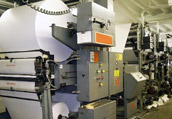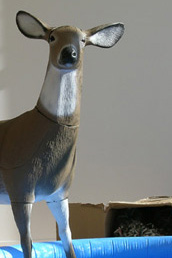McClelland & Stewart at the Stitching Helm
Amatoritsero Ede in Conversation with David Ward

David Ward is the production manager at McClelland & Stewart for Random House of Canada. He manages the production of all titles for both McClelland & Stewart and Tundra Books. He has worked for trade, educational, and clinical assessment publishers and is well versed in the production of all manner of publications. He is also an instructor at The Chang School at Ryerson University, where he has taught Production for Books, Journals, and Reports.
Amatoritsero Ede: What are M & S' preferred book production processes? By this I mean - does your house apply traditional printing practices or the new Publish on Demand (POB) methods?
David Ward: McClelland & Stewart and Tundra use a variety of production processes, including traditional printing, i.e., using web and sheet-fed offset presses, and print-on-demand technologies. Cost, speed, and quality are the deciding factors. Print-on-demand processes are getting better by the day, and they're quite appealing for short- to medium-run titles or reprints. Print-on-demand still has a cap on quantity, and it simply doesn't make sense to print digitally at higher numbers. Traditional offset printing is still far superior for large print-runs. For most of McClelland & Stewart and Tundra titles, offset printing is the preferred method.
A.E.: Is there ever a mix of traditional book process and new media for particular books or editions - say in the case of audio books, or material that might be in POB and solid print form?
D.W.: Yes, media are mixed from time to time. Books can be packaged in any number of ways with any number of pieces. These can be challenging to coordinate as the production person has to deal with a number of different vendors, but they're by no means impossible. Component printing is common in trade publishing; it's just a question of what those components comprise.
A.E.: For purely traditional publishing, could you kindly describe for us the initial processes or stages in your production effort, beginning with editorial stage (mark-up), galleys, to the preparation of dummies - or mock-up, paper estimations, print run, and so on.
D.W.: In a standard workflow, the manuscript heads to editorial for a substantive edit. This can take quite a long time, but once it's done, the vast amount of structural work should be finished. The manuscript is then copyedited. Copyediting is part of the production process, but at McClelland & Stewart the editorial team handles it. The copyedited manuscript is delivered to production, and an out-of-house or in-house typist keys the changes, or the clean file, if the copyedit was done electronically, is sent directly to the typesetter. A number of copyeditors still use pencil and paper, though there is a move to do everything on screen. At some point, however, there is a clean, copyedited manuscript, and that's submitted to the typesetter. While the substantive edit is going on, we produce an interior text design, which is also submitted to the typesetter, preferably before the copyedited manuscript is cleaned up. At this point, the typesetter should have an established design and a clean file so they can get to work on creating pages. We usually run through three sets of pages - 1st, 2nd, and 3rd, respectively - and while these are being passed back and forth between editorial and production, two other things are going on: laying out the jacket/cover, and setting up costs to determine how many to print. Once I know how many to print (this is decided by publishing), I submit a purchase order along with all of the relevant files to the printer. The printer will produce a set of proofs of all materials and send it to me for final approval. This is not the time to make changes, but it's a final approval stage just to ensure everything loaded and output correctly. Several weeks later finished books are sent to me as advance copies, a production check is done to ensure everything is where it's supposed to be, and we allow the books to be received in the warehouse. Books are shipped out to customers, and the final files are archived.
A.E.: Ideally what would be your choice of a printing machine; do you have a say in this or do you simply go with the infrastructure of a particular printer?
D.W.: Publishers don't dictate the actual presses used by a printer, but they will only use printers who have the right equipment to make the books they need. If a printer is found lacking, then it can make sense to move the book to another one. Luckily, in both Canada and the United States, there are some large, major printers with some excellent equipment that can produce pretty much any book a publisher could ever want. It boils down to the publisher's requirements - can the printer produce what's needed? Usually the answer is yes, but when it's no, it makes sense to either go elsewhere or perhaps see what can be done.
A.E.: What informs your decision on the details of the production process - paper type, colour separation (where necessary), number of pages, print finishing (i.e. types of binding).
D.W.: Paper, colours, special production features, and binding types are all determined by a mix of cost, time, and perceived value to the customer. In all cases, I'll do sets of comparative costs and outline the time needed to pull off these features, if necessary. Generally we choose standard colour outputs: 1-colour (almost always black) or 4-colour (cyan, magenta, yellow, and black). Obviously 1-colour is less expensive, and it's the standard for most trade books. Really special features, like die-cuts, embosses, etc., are used on a case-by-case basis, as are choices to use non-standard papers or binding types.
A.E.: In deciding printing finishing (binding) do you consider warehousing conditions, or the possible wear-and-tear of distribution?
D.W.: Yes, certainly. Shipping and fulfillment can be very hard on a finished book, regardless of where it's printed. Domestic and foreign printers need to pack the books to our requirements and ship them to our warehouse, and from there they head to our customers; that's a lot of handling. If a book is covered in special production features like die-cuts, flocking, or special coatings, it can cause problems. Even colour is an issue: scuffing, that is marks on a jacket or cover, can happen at almost stage. Some colours show this worse than others, as do some laminations.
A.E.: When is a hardcover or paperback binding necessary or superfluous?
D.W.: It's very difficult to say. Some argue that all hardcover binding is superfluous, but many, myself included, are big fans of the format. The standard process is to produce a hardcover and then a trade paperback or mass-market edition. That being said, there are a number of trade-paperback original editions, and some books continue to sell as hardcovers. Publishing (Editorial Department) usually makes format decisions, but format will often dictate where to print a book, which is where production comes in. Some printers are better suited to print paperbacks, while others are better for hardcovers.
A.E.: When there are serious errata in a finished book - if ever - due to impurities imported during any stage of production, what measures do you find useful for corrections?
D.W.: All of our books go through at least three sets of pages, or proofs, and that's even before they go to the printer. While major problems can arise, they're pretty rare. Still, when they do happen, we determine what to do on a case-by-case basis. Did the problem come from the printer? Did it come from us? I find most major problems are eliminated by three sets of pages and a printer proof once files have been submitted. While printer proofs should never be taken as an additional set of pages, they're incredibly useful if something does need to change or if files have been corrupted in some way.
A.E.: Do you prefer that older and still very dependable book production formula - i.e. from paper to film to plate-making, and finally printing?
D.W.: Film is all but extinct, but the rest of the process has remained largely intact. Camera-ready copy and film have been replaced by computer-to-plate technology, but the use of plates and offset printing is still a mainstay of book printing. Digital printing is getting better by the day, but offset is still favoured by most publishers. As I mentioned, though, offset printing isn't always that economical for short or medium runs. I cannot see a use for film in this day and age; it deteriorates and takes up space.
A.E.: Thank you very much for taking time out of your heavy schedule for this.





